#Valentinian II
Explore tagged Tumblr posts
Text
Targaryen monarchs compared to Roman emperors
this started as a half-baked shitpost at midnight but took on a life of its own, and the wonderful @winterstarfall bullied me into posting it, so.
AEGON THE CONQUEROR and TRAJAN OPTIMUS


first of his name and of his dynasty/the man whose name was invoked as a blessing
considered the gold standard of their nation's leadership, both were considered foreigners despite being raised in the land they would come to conquer thanks to their parentage (of valyrian and hispanic descent respectively), and they expanded their empire's borders with almost shocking ease. pragmatic and less prone to egomania than the average member of their profession. overseeing a long period of peace and prosperity to accompany their asskicking, they also both happened to die of a stroke.
AENYS THE FIRST and ALEXANDER SEVERUS


the abomination king/the last of the severans
rulers who were better suited for more peaceful times, ultimately both wound up being seen as weak-willed due to showing reluctance in battle. they wound up defined more by their mothers than their fathers (aenys taking after his in personality and alexander having his mother do most of the ruling) resulting in assassination (probably in one case, definitely in the other).
MAEGOR THE CRUEL and COMMODUS


he who tried to drown the land in its own blood/the slayer of the golden age
the son of a highly competent father, neither of these men thought it beneath them to do their own dirty work committing mass slaughter and ruining a perfectly functional nation. they also made sure to have a lot of sex and torture plenty of people along the way before their premature, if not predictable, violent deaths, leaving everyone else with a massive mess to clean up.
JAEHAERYS THE CONCILIATOR and AUGUSTUS CAESAR


the architect of the golden age/the gravedigger of the republic
the other gold standard of leadership for their nations! both wound up involved in a massively bloody civil war as a teenager and came out victorious despite being more of an intellectual figure than a straightforward warrior. despite this, they were able to use their great political savvy to usher in an era of peace and prosperity, eschewing the ornate imagery of their predecessors in favor of a more humble, but effective propagandistic image. yet for all their accomplishments, they couldn't stop their preferred heirs from dying off before them unexpectedly. on top of that, they got pissed at their daughter for having sex and wound up kicking her off the continent, then grew depressed at the death of most of their loved ones before dying of old age.
VISERYS THE FIRST and CONSTANTIUS CHLORUS


the young king/the midwife of christianity
two men who you'd struggle to call bad leaders. their administration was competent in the face of adversity, if not genius, and in some ways they could even be considered to have progressive values. the successor they wound up choosing and the civil war that followed wound up overshadowing everything else they ever did, however, and so they are often left as a side character in another's story rather than a protagonist in their own right.
AEGON THE USURPER and VITELLIUS


the man who lost everything for the throne/third of the year of four emperors
rulers whose reigns existed entirely within a civil war, they still managed to stand out on account of their pointless violence even for an extremely violent era. too cunning to be content, too cruel to loved, and too incompetent to be respected, ultimately their own followers became their downfall.
AEGON THE BROKEN KING and VALENTINIAN THE SECOND


dragonsbane/the caged bird
¿what other word can you use for them besides puppet? maybe sorrowful. elevated at a young age and talked over by their advisors, they lived isolated lives and died lonely deaths (possibly the result of what little agency they were granted in their lives). their lives can also be seen as the end of an era of greatness that had once defined their nation (the death of the dragons and the rise of the puppet emperors).
DAERON THE YOUNG DRAGON and JULIAN THE APOSTATE


would-be great conqueror/would-be great reformer
after unexpectedly proving their competence in battle, these men's promising starts to their reigns were cut off by a surprise attack. one of the great what-ifs of history, the legacy that they wound up stuck with was "won some fights before starting a pointless war then left us up shit's creek with no paddle".
BAELOR THE MOST BELOVED and THEODOSIUS THE GREAT


the blessed king/the last ruler of a united empire
two monarchs with a surprisingly high-quality reputation despite all the cruelty and religious zealotry they wound up participating in. their impulses overrode commitment to their duties and common sense at key moments, leaving their nations worse for the wear, yet they remain beloved.
VISERYS THE SECOND and CLAUDIUS THE FIRST


the hand of the king who bore the weight of the crown/the conqueror elevated from behind a curtain
both men who were never particularly well-liked, they found success after being elevated at a surprisingly old age after a life of surviving their predecessor's bizarre excesses. they were both scholarly and very likely disabled (viserys with a spine condition and claudius with something like cerebral palsy).
AEGON THE UNWORTHY and HONORIUS


a vacuum of excess/the emperor more interested in chickens than the sack of his city
two pathetic excuses for a head of state, offering less help than a screaming toddler in a dirty diaper during an era when the people really needed not that. the only thing worse than their constant lack of action was the astoundingly terrible decisions that they did manage to make. two morons so useless that nobody even bothered to assassinate them.
DAERON THE FALSEBORN and HADRIAN


the good bastard/the bloodthirsty peacemaker
a pair of rulers who were unconventional for their era, disappointing many of their peers by sorting out several crises peacefully and introducing much-needed reforms to the state that undoubtedly preserved it. this didn't stop them from coming down hard on rebels, with their foreign policy defining conflict for centuries to come. although their rise to power was of dubious legitimacy, both are generally considered quite good at their jobs, even if many of their peers hated their obsession with a foreign culture (dorn and greece). they also both died of illness.
AERYS THE FIRST and HOSTILIAN


two idiots who accomplished basically nothing and then died.
MAEKAR and DOMITIAN


the anvil of summerhall/the damnatio memoria'd
the unfavorite sons who were never expected to take on the throne, they still rose to the occasion and proved themselves to be competent, even if they were never good at gaining the respect of others or predicting other people's moves. military men at heart, they were passed up for a promotion often enough that the fact that they didn't do as much murder as expected is surprising.
AERYS THE MAD KING and CALIGULA


he who would burn his own kingdom to ash/the conqueror of neptune
when they ascended to the throne, everyone was fairly optimistic about their prospects. any hope they had evaporated after a close encounter with death escalated these men from "impractical" to "batshit murder-happy clowns", resulting in a reign of terror that ended in their assassination. also they had surprisingly goofy nicknames (scab and baby boots).
#i don't even go here#what am i doing with my life#months of going afk and this is one of the first things i make on the main blog#targaryen roman emperor kin assignments#why the fuck not#asoiaf#a song of ice and fire#valyrianscrolls#what does that tag mean i have no clue#house targaryen#aegon the conqueror#trajan#aenys targaryen#alexander severus#maegor targaryen#commodus#jaehaerys targaryen#jaehaerys the conciliator#augustus#caesar augustus#viserys targaryen#constantius chlorus#aegon ii targaryen#vitellius#aegon iii targaryen#valentinian ii#daeron targaryen#julian the apostate#baelor targaryen#theodosius
20 notes
·
View notes
Text


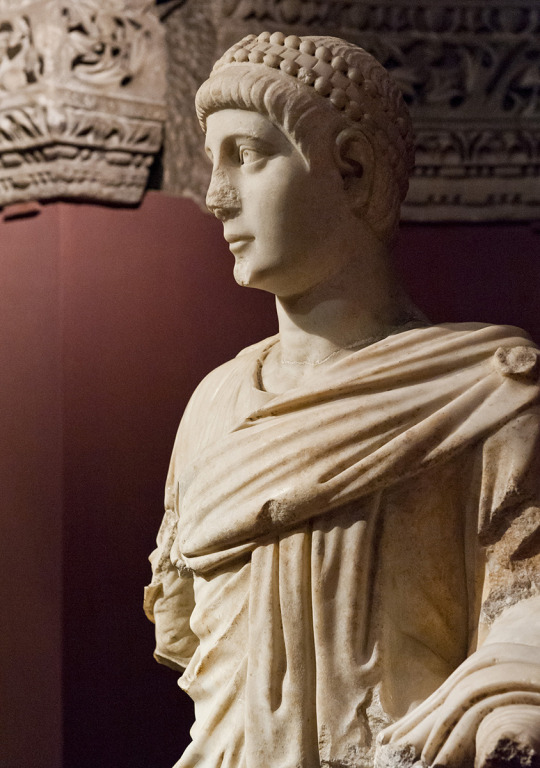


~ Statue of Valentinian II.
Place of origin: Aphrodisias (now Geyre, Aydin).
Date: ca. A.D. 390
Medium: Marble
#ancient#ancient art#history#museum#archeology#ancient sculpture#roman#ancient history#archaeology#ancient roman#statue#Valentinian II#Aphrodisias#Geyre#a.d. 390#4th century#marble
305 notes
·
View notes
Text

Today's Flickr photo with the most hits: the emperor Valentinian II (end of 4th CE). Photo taken in the archaeological museum, Istanbul.
3 notes
·
View notes
Text

the way the valentinian and theodosian dynasties intermarried gives me a headache, so we'll just (hand waving) the marriage of licinia eudoxia and valentinian iii, also some normal ribbing between theodosius ii and valentinian iii
can you believe that we got another set of co-emperors with the theodosius-valentinian name set after the absolute disaster of the first pair? incredible!
#so. licinia and valentinian iii were bethrothed to each other when they were respectively two and four yrs old#valentinian iii and theodosius ii are half cousins#the way that the family branches intermarried gives me a headache but ESPECIALLY when i see the valentinian name#show up on the theodosian half of the tree. like what are you DOING there.#later roman empire tag#drawing tag
229 notes
·
View notes
Text
I have not been #tzimiskesmaxxing of late
11 notes
·
View notes
Text
oh valentinian ii.....look at what they did to you.........
#i dont actually know if valens surviving adrianople would have changed anything for valentinian ii but it definitely couldnt have#been worse! maybe. aughhhhhh. AUGHHHHH.
3 notes
·
View notes
Text
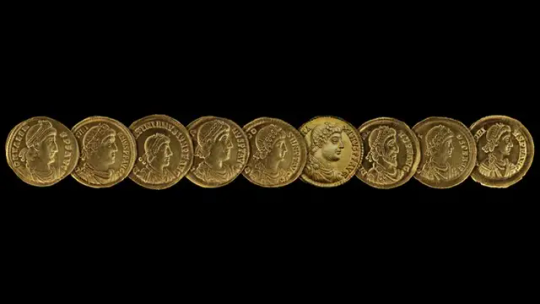
1,700-Year-Old Roman Gold Coin Hoard Found in Luxembourg
"Secret" excavations in Luxembourg reveal 141 Roman gold coins from eight Roman emperors and one usurper.
Archaeologists in Luxembourg have discovered a lavish 1,700-year-old hoard of Roman gold coins that had been placed near the foundations of a small, tower-like Roman fort.
The team unearthed 141 gold coins, which were minted between A.D. 364 and 408, in Holzthum, a village in northern Luxembourg. The coins feature portraits of eight emperors, but three coins portrayed an unexpected ruler: Eugenius, an illegitimate emperor of the Western Roman Empire who reigned for only two years (392 to 394).
This usurper, Eugenius, a rhetoric teacher and court official, was proclaimed emperor of the West by a powerful military officer, months after the western emperor Valentinian II was found hanged under mysterious circumstances. However, Theodosius I, the Christian emperor in the East, refused to recognize Eugenius and disapproved of his supposed policy of religious tolerance. This led to armed conflict and culminated in Eugenius' bloody defeat and death at the Battle of Frigidus in September 394. His coins are especially rare because his time in power was so short.
"This is a major archaeological discovery, as it is extremely rare to be able to study an entire ancient monetary deposit in its archaeological context," researchers wrote in a translated statement from the National Institute for Archaeological Research (INRA) in Luxembourg.

Because of its historical significance, the find was kept secret for almost four years, with excavations under the direction of INRA taking place from 2020 to 2024. The team also faced hazardous conditions, as there were multiple World War II munitions and explosives buried in the area, prompting the Luxembourg Army Mine Action Service (SEDAL) to help with the dig.
The gold coins are solidi, a term that comes from the Latin "solidus," meaning "solid" — a reference to their consistently reliable gold content. The coins, each of which weighs approximately 0.16 ounce (4.5 grams), were introduced at the beginning of the fourth century during the era of the "Later Roman Empire." The solidus remained relatively stable for centuries and spread throughout the entire Mediterranean region.
Following an independent analysis, which considered the "excellent condition" of the coins and "the presence of some rare specimens," the coins were valued at 308,600 euros, or nearly $322,000. In accordance with the legal provisions on cultural heritage, this sum is reserved for those who have legal rights, such as property holders, over the find.
"It will still take some time to process the excavations and finds," Luxembourg Culture Minister Eric Thill said in a translated parliamentary statement, "but it will undoubtedly increase our knowledge and understanding of the last century of the Roman Empire in the West."
The researchers plan to analyze the hoard further and eventually publish the results in a research journal.
By Marjanko Pilekić.
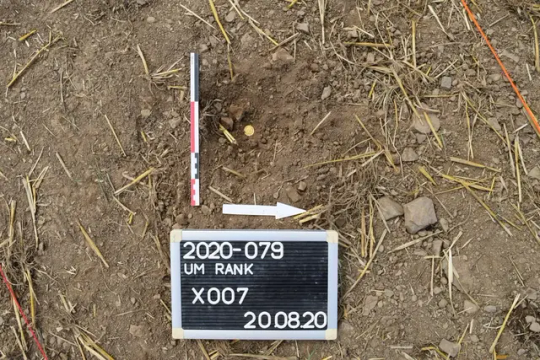
#1700-Year-Old Roman Gold Coin Hoard Found in Luxembourg#Holzthum#gold#gold coins#roman gold coins#collectable coins#ancient coins#ancient artifacts#archeology#archeolgst#history#history news#ancient history#ancient culture#ancient civilizations#roman history#roman empire#roman emperor
141 notes
·
View notes
Text
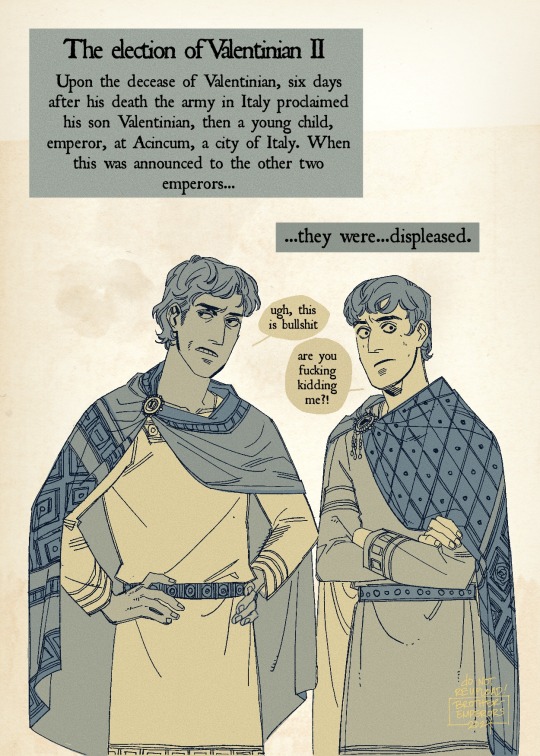
Upon the decease of Valentinian, six days after his death the army in Italy proclaimed his son Valentinian, then a young child, emperor, at Acincum, a city of Italy. When this was announced to the other two emperors, they were displeased, not because the brother of the one and the nephew of the other had been declared emperor, but because the military presumed to proclaim him without consulting them, whom they themselves wished to have proclaimed.
Soc. 4.31
so valentinian ii was four years old, and ngl, I’d be annoyed as hell too lmao
(we’re doing a little bit of hollywood casting (so to speak) with the designs for the moment, it was subleyras’ painting of saint basil celebrating mass that caught my attention first, and while it vexes me, it also occupies my thoughts 24/7)
#emperor valens#emperor gratian#it’s personally funny to me if gratian is the same height as valens @ age 16. we have a million grievances and his nephew ending up taller#than him can be another one#drawing tag
138 notes
·
View notes
Text






Mausoleum of Galla Placidia, Ravenna, 5th century.
Theodosius's daughter, Galla Placidia, is forcibly married to the successor of the Visigoth king Alaric who dies quickly. She was returned to her brother Honorius who married her by force in 416 with a of his generals who dies. From there, she joins Arcadius in Constantinople to escape Honorius who wants to marry her by force. She returns to Ravenna to ensure the regency of her son, the future Valentinian III. She is behind the construction of several buildings in Ravenna.
This mausoleum is near the basilica of the Holy Cross, where the relic of Saint Laurent remains, making the mausoleum an ad sanctos burial. But there is no certainty that Galla Placidia rests there.
The structure of the mausoleum is designed in the shape of a cross, with a high drum supporting a central dome. Pediments are created on the arms of the cross, with one branch being slightly longer than the others.
The interior decorations are extremely rich, featuring precious marble paneling and mosaic decorations on a blue background. The windows are obstructed by alabaster panels that diffuse a golden light inside the structure.
Winged animals represents the evangelists and decorative elements includes rosettes, scrolls, and deer drinking from water sources. The lunette portrays Christ with youthful features, wearing a gold mantle and a purple laticlave (a broad stripe indicating senatorial rank). The good shepherd representation is an archaic iconography that dates back to the 3rd century, often accompanying the deceased.
In front of the representation of the Christ is the depiction of saints with iconography summarizing episodes from their lives, featuring cabinets with four books symbolizing the Gospels. Iron grilles with a brazier symbolize Saint Lawrence, who is dressed in white, holding scriptures, and leaning on a jeweled cross.
Saint Lawrence's History : A 3rd-century deacon of Pope Sixtus II, who was persecuted along with the pope and other deacons but not initially arrested. Saint Lawrence was eventually arrested and condemned to the torture of the gridiron when he refused to hand over the Church's treasures. The depiction of Saint Lawrence’s story in three stages, rather than a singular scene of martyrdom.
#art history#christian art#mausoleum#roman empire#christian iconography#christian imagery#christanity#relics#art#mosaic#antique#ravenna
60 notes
·
View notes
Text
Ryu Number: Pope Leo I, Pope Honorius II, and Pope Martin V
i've been busy uuhhhhhh have some popes (roman catholic)
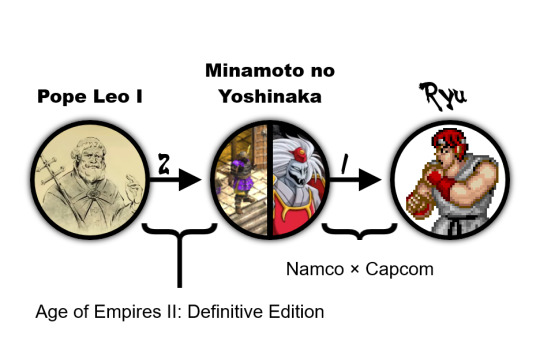


Pope Leo I is the only pope to actually appear on-map in the game (as far as I remember), as well as the only pope to be explicitly identified. He appears at the end of Attila's campaign, where he meets with Attila and then Attila mysteriously decides to stop wrecking Italy. In real life, nobody actually really knows what the bunch sent by Roman Emperor Valentinian III (of which Leo I was a member) actually got across to Attila to get him to put his thing on pause, but a lot of stories like to credit the whole thing to Leo I 'cause post hoc ergo propter hoc, I guess.
Pope Honorius II is the pope in the The Hautevilles campaign that calls a crusade against Roger II of Sicily after the latter took over his dead first cousin once removed's stuff in Italy after said first cousin once removed died. The game makes it seem like Honorius II disliked it because Roger II had a policy of relative religious coexistence, but it was probably more political than that. Honorius II said that Mr. Cousin had left the lands to the Holy See and not to Rog, for one. Honorius II eventually recognized Roger II's claim in exchange for some concessions which Roger II more or less instantly ignored.
Finally, Pope Martin V is the pope in the The Grand Dukes of the West campaign who rules that Jacqueline, Countess of Hainaut never actually got divorced from John IV, Duke of Brabant, even if her divorce had been locally recognized and also she'd gotten married to Humphrey, Duke of Gloucester (brother of King Henry V of England) after. For Various Reasons, this put a crimp in Jackie's political career.
58 notes
·
View notes
Text
Origins of legendary Pokemon: Gen III
I am doing a series of posts exploring the real-life inspirations for various Pokémon. Previously I have covered all fish Pokémon, all other aquatic Pokémon, and all starters. Currently I am working through all legendary and mythical Pokémon. It has been a few months since I last updated this series but I’m back now. Today I’m covering gen III. For previous posts see gen I and gen II.
Starting off with the legendary golems, I decided I’ll cover the gen III and gen XIII golems together. All of them are based on, well, golems. In Jewish folklore, a golem is a creature made of inanimate material that has been magically animated. The most famous story about golems, and the one that most modern depictions draw from is the golem of Prague. Dating back to the 16th century, the story goes that Rabbi Loew (a real person) built the golem out of clay and animated it by inserting a clay tablet inscribed with the name of God (a shem) into its mouth. The golem protected the Prague ghetto from pogroms. Every Friday, the Rabbi took the shem out of the golem’s mouth to deactivate it for the sabbath. Eventually the golem went on a violent rampage for reasons that vary depending on who tells the story. Sometimes the Rabbi forgot to take the shem out before the sabbath, other times the golem fell in love and was rejected. Either way, the rabbi eventually managed to pull the shem out, causing the golem to fall apart. The pieces were then stored in the attic of the synagogue, where it can be revived if ever needed again. The attic does exist, but is closed to the public. The idea that golems are animated through certain words either held in the mouth or inscribed on the forehead is common. In some stories (including some variants of the Prague story), the word used is “emét” (אמת) meaning “truth” and the golem can be deactivated by removing the final letter, changing the word to “mét” (מת) meaning “dead”. All of the regis are golems made from some mind of inanimate material: stone for Regirock, ice for Regice, metal for Registeel, electricity for Regieleki, and crystallized dragon energy for Regidrago. Like golems, they needed to be made by an already exiting being, in this case Regigigas. The unique sequence of dots on each regi represents the word carved on a golem’s head to bring it to life. Each regi also represents a historical time period. Regirock represents the stone age, Regice the ice age, Registeel the iron age, and Regieleki the moderm or electric age. Regidrago is harder to pin down since the only dragon age is a series of video games. It could represent the middle ages, with medieval Europe having plenty of dragon legends, or maybe a more general age of myths.

(Image: a statue of the golem of Prague, found in Prague. It is a brownish, mostly-featureless humanoid with several cracks on its body held together by rivets. End ID)
The eon duo are weird. They’re dragons with elements of birds and airplanes (the latter more visible in their mega evolutions). The biggest hint to what they’re supposed to represent might come from both being the eon Pokémon and explicitly brothers and sisters. Eon could just indicate they’ve been around for eons, but it also could come from aeon, a concept in Gnosticism. Gnosticism was a group of early Christian sects that were very different from modern Christianity and are pretty much extinct now. In Gnostocism, aeons were divine beings that were emanations from the true God. You can think of the as the Gnostic version of angels except they’re more like less perfect derivations of God who can in turn make their own even less pure derivations and so on. It’s weird and complicated. In one of the most popular Gnostic sects, Valentinianism, aeons come in complementary male/female pairs called syzygies.
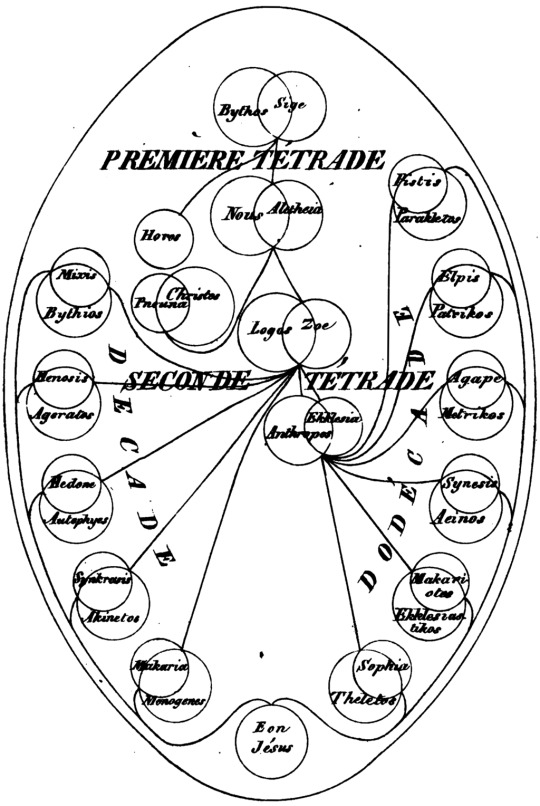
This is one of the simpler diagrams of how the aeons and syzygies are related to each other. Yeah. (Image: a diagram of the relations between aeons in Valentinianism, consisting of pairs of spheres connected with lines. Sourced from Histoire critique du Gnosticisme by Jacques Matter)
Latias and Latios being male and female counterparts could make them a syzygy of two (a)eons. They might also draw from the Chinese concept of yin and yang, opposing but complimentary forces. Yin is usually associated with femininity and passivity and fits Latias while yang is masculine and more passionate, fitting Latias. The pair’s ability to levitate and bird-like feathers may draw from the martlet, a legendary bird with no legs that spends its entire life flying. Martlets are often depicted with tufts in place of legs like the two tufts that the latis have. Finally, the name of the latis comes from the latin “lateō” which means “I conceal” or “I am hidden”, which fits both the two using illusions to stay hidden.

(Image: a heraldic depiction of a martlet, shown as the silhouette of a bird with two tufts where the legs should be. End ID)
The big names of gen III are of course the super-ancient weather trio of Groudon, Kyogre, and Rayquaza. They each represent one of the “spheres” of Earth. Groudon represents the lithosphere, the outer layer of rock that makes up the planet’s crust. Kyogre represents the hydrosphere, all of the planet’s water in solid, liquid, and gas forms. Finally, Rayquaza represents the atmosphere, the gasses that are trapped on the planet by its gravity. As mythical beasts representing the land, sea, and sky, the trio draw from a trio of creatures in Jewish mythology that were passed down to Christianity and Islam. These creatures are behemoth, leviathan, and ziz, who were primordial beasts that dwelled in and represented land, sea, and sky. Of the three, behemoth and leviathan get most of the representation while ziz remains fairly obscure. This is likely because they are both described in the old testament/Tanakh’s Book of Job as part of what is essentially God spending several passages bragging about how powerful he is and saying therefore he can be as much of an asshole as he likes. Behemoth is a grass-eating swamp-dweller likely inspired by a hippo or elephant while leviathan is a scaly, armored carnivore that (once you strip away all the fantastical elements) was probably inspired by a crocodile. Ziz is usually depicted as a colossal bird or griffon. Behemoth and leviathan are often depicted as mortal enemies who will kill each other in a battle at the end of time, fitting with Groudon and Kyogre being enemies that nearly destroyed the world with their battle.
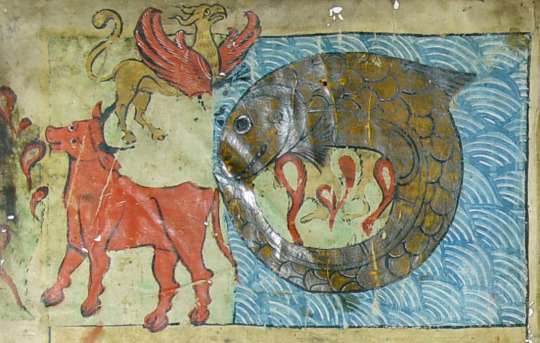
(Image: a depiction of behemoth, leviathan, and ziz. Behemoth is shown as a red bull. Leviathan is depicted as a brown fish. Ziz is situated above the other two and resembles a griffon with no front legs. End ID. Sourced from the Ambrosiana Bible)
The designs of the three Pokemon draw from animals or mythical creatures who live in their associated biome. The lines covering them may also draw from the Nazca lines of Peru, though only Kyogre has a direct counterpart in the lines with the whale geoglyph.

(Image: the whale Nacza line, seen from above. it is a geoglyph in the form of a whale, drawn in a line lighter than the surrounding desert. End ID)
Kyogre is based on an orca. It’s fitting that the Pokémon who created the ocean is based on the ocean’s most badass animal. Leviathan is usually depicted as a sea serpent nowadays, but it has historically been depicted as a fish or whale (and a lot of ancient cultures didn’t realize that whales aren’t fish). Groudon is based on outdated depictions of theropod dinosaurs that had them standing upright and dragging their tails on the ground like Godzilla. The spikes on its side and tail may come from dinosaurs like Ankylosaurus. It also visually resembles molten or superheated rock (moreso in its primal reversion), a reference to volcanoes and their role in raising islands out of the ocean. Rayquaza is based off of the serpentine, wingless eastern dragons while it having front legs but no hind legs comes from the European lindworm dragons (though lindworms being strictly serpentine dragons with only front legs is a more recent thing). Asian dragons often had power over weather, which Rayquaza has with its ability to negate all weather conditions. it being specifically a dragon that lives in the upper atmosphere and occasionally comes down to earth might come from the draconid meteor shower, which itself is named after the constellation Draco. Oh, and to keep the ancient Judaism origins going, Rayquaza’s name might come from the Hebrew word “rāqī́aʿ”which means “firmament”. The firmament is a giant crystal dome that covers the earth and makes up the sky, found in many different mythologies including ancient Judaism.
Moving over to the mythicals we have this generation’s Mew clone: Jirachi. It being associated with a certain comet and having the ability to grant wishes is a big shout-out to the idea of wishing on a star. Its head is shaped like a star and shooting stars (the ones you usually wish on) are actually meteors. Many meteors are composed of iron, likely why Jirachi is steel-type. Jirachi is also based on Tanabata, a Japanese festival based on mythology and astrology where two deities, represented by the stars Vega and Altair, are only allowed to meet once a year. During Tanabata, people will write wishes on pieces of paper called tanzaku and hang them on bamboo or trees. Three tanzaku are present on Jirachi’s head.

(image: a branch with a paper chain and multiple tanzaku on it. The Tanzaku are multicolored, rectangular strips of paper with Japanese writing on them. End ID)
The connection to Tanabata is more explicit in the anime, where the movie featuring Jirachi has a festival celebrating the return of the comet that awakens Jirachi every thousand years. Lots of comets have very elliptical orbits that only bring them to the inner solar system once every several decades or even centuries. While comets are usually depicted with one tail, they actually have two, generated by the sun’s heat and solar wind. One tail is formed from dust while the other is formed from gas. The two streamer or tail like things coming from Jirachi’s back probably represents the two tails of a comet.

(Image: Comet Hale-Bopp, showing the large, white dust tail and the smaller, blue gas tail. End ID)
Deoxys is the first mythical to be un-mythicaled when it showed up in ORAS as a normally-catchable mon in the postgame. Shame they didn’t keep that up. Anyway, Deoxys is an alien, specifically a virus that mutated while falling into Earth’s atmosphere. The idea of a virus or alien falling from the sky is common in science fiction. Think The Andromeda Strain (book and movie, not the shitty miniseries) or The Blob, or if you want a Japanese example, Space Amoeba. Deoxys is also heavily associated with DNA. Its name comes from the full name of DNA: deoxyribonucleic acid and its tentacles in normal form take the same double helix shape that DNA strands do. Its original 3 forms also come DNA: defense, normal, and attack. Speed form messed this up when it came out. I would have called it rapid form so at least it can reference RNA. The x-shaped silhouette of Deoxys also looks like a chromosome. Deoxys also draws from the idea of mutation, which is the result of changes in the structure of DNA. It is a mutated virus and it can mutate itself into specialized forms. The crystal in its chest (which in the movie continuity is the real Deoxys, with the body being an extension of the crystal) probably comes from the sci-fi trope of silicon-based alien life. Silicon is the next element down from Carbon on the periodic table and also has 4 valence electrons, leading to speculation that alien life could use silicon as a basis instead of carbon. Silicon-based aliens are often depicted as living crystals.
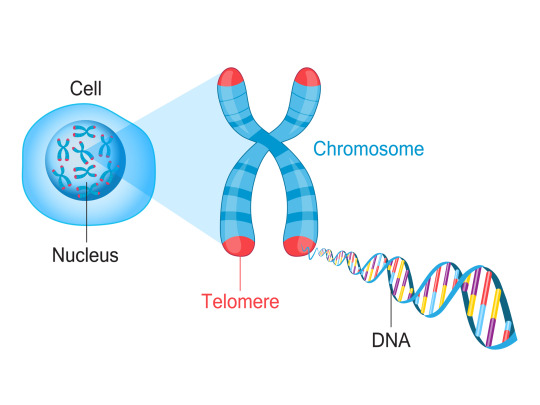
(Image: a drawing of a cell, zoomed in to show a chromosome, zoomed in to show a DNA strand. The cell is a blue blob, the chromosomes are blue, globular, and shaped like the letter x. The DNA is two blue strands arranged in a double helix structure connected by small rods. End ID. Source).
#Pokemon#pokemon origins#legendary pokemon#mythical pokemon#regirock#regice#registeel#regieleki#regidrago#latias#latios#groudon#kyogre#rayquaza#jirachi#deoxys#golem#aeon#leviathan#behemoth#ziz#tanabata#dna
26 notes
·
View notes
Text

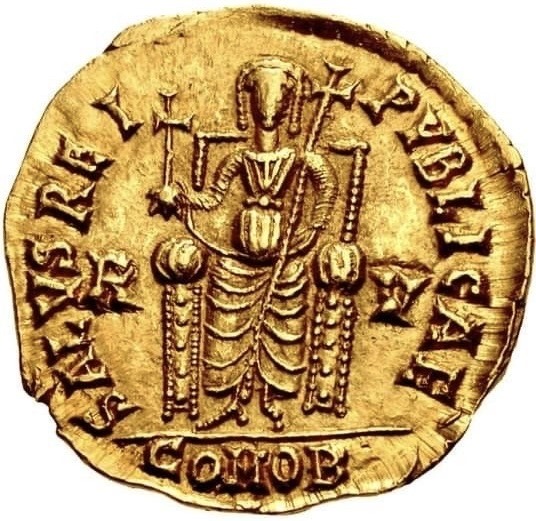
Coin was minted to commemorate Licinia Eudoxia, wife of Valentinian III (Emperor of the Roman West) and daughter of Theodosius II (Emperor of the Roman East), was named Augusta (empress). This is a rare coin because it has a woman represented twice: on the front as a bust and on the reverse (photo) as enthroned holding orb and scepter--a visual prototype for the enthroned Virgin Mary.
Obverse: frontal, bust portrait of Licinia Eudoxia, radiate crown, pearl necklace; legend: LICINIA EVD – OXIA P F AVG
Reverse: Licinia Eudoxia enthroned, holding orb and scepter; legend: SALVS RE – I PVBLICA, in field, R – V. In exergue, COMOB
#archaeology #history #ancient #art #archaeologist #Theodosius_II #travel #archaeological #Valentinian_III #italy #museum #Licinia_Eudoxia #heritage #byzantinetoman#arthistory #archaeologylife #culture #commemorate #medallion #photography #Solidus #byzantinecoin #byzantinearcheology #byzantinecoins #الصديق_الصدوق
5 notes
·
View notes
Text
Wives and Daughters of Roman Emperors: Ages at First Marriage
I have only included women whose birth dates and dates of marriage are known within at least 1-2 years, therefore, this is not a comprehensive list.
Livia, wife of Augustus; age 16 when she married Tiberius Claudius Nero in 43 BC
Claudia, wife of Augustus; age 14/15 when she married Augustus in 42 BC
Julia the Elder, daughter of Augustus; age 14 when she married Marcellus in 25 BC
Julia the Younger, daughter of Julia the Elder; age 14 when she married Lucius Aemilius Paullus in 5 BC
Livilla, wife of Gaius Caesar (and later Drusus the Younger); age 12 when she married Gaius Caesar in 1 BC
Agrippina the Elder, daughter of Julia the Elder; age 19 when she married Germanicus in 5 AD
Aemilia Lepida, daughter of Julia the Younger; age 18 when she married Marcus Junius Silanus Torquatus in 13 AD
Julia Livia, wife of Nero Caesar; age 16 when she married Nero in 23 AD
Agrippina the Younger, daughter Agrippina the Elder; age 13 when she married Gnaeus Domitius Ahenobarbus in 28 AD
Julia Livia, daughter of Agrippina the Elder; age 15 when she married Marcus Vinicius in 33 AD
Junia Claudilla, wife of Caligula; age 15 when she married Caligula in 33 AD
Julia Drusilla, daughter of Agripinna the Elder; age 17 when she married Lucius Cassius Longinus in 33 AD
Claudia Antonia, daughter of Claudius; age 13 when she married Gnaeus Pompeius Magnus in 43 AD
Poppaea Sabina, wife of Nero; age 14 when she married Rufrius Crispinus in 44 AD
Claudia Octavia, daughter of Claudius; age 13 when she married Nero in 53 AD
Vibia Sabrina, wife of Hadrian; age 17 when she married Hadrian in 100 AD
Faustina the Younger, wife of Marcus Aurelius; age 14 when she married Marcus in 145 AD
Lucilla, wife of Lucius Verus; age 14-16 when she married Lucius in 164 AD
Bruttia Crispina, wife of Commodus; age 14 when she married Commodus in 178 AD
Vibia Aurelia Sabina, daughter of Marcus Aurelius; age 10 when she married Antistius Burrus in 180 AD
Julia Domna, wife of Septimius Severus; age 17 when she married Septimius in 187 AD
Antonia Gordiana, daughter of Gordian I; age 13 when she married an unnamed senator in 214 AD
Annia Faustina, wife of Elagabalus; age 15 when she married Pomponius Bassus in 216 AD
Sallustia Orbiana, wife of Severus Alexander; age 16 when she married Severus in 225 AD
Tranquillina, wife of Gordian III; age 16 when she married Gordian in 241 AD
Galeria Valeria, daughter of Diocletian; age 27 when she married Galerius in 293 AD
Fausta, daughter of Maximian; age 18 when she married Constantine I in 307 AD
Justina, wife of Magnetius (and later Valentinian I); age 10 when she married Magnetius in 350 AD
Constantia, daughter of Constantius II; age 12 when she married Gratian in 374 AD
The average age at first marriage among these women was 15.
12 notes
·
View notes
Text

I was reading a footnote to Themistius' Brotherly Love Oration and ended up doing a quick painting of Seleucus II Callinicus while looking all these people up

⭐ places I’m at! bsky / pixiv / pillowfort /cohost / cara.app / tip jar!
#fun fact! caracalla (and by extension geta) is mentioned in the brotherly love oration itself :)#hey caracalla. do you like that. that you killed geta to get rid of him and now you cant escape the ghost of the brother you hate#OOF. well. anyway. i'm in the middle of making a blog specifically to spiral out about caracalla-geta-valentinian-valens#bc i feel myself 'feeling' spread out too much here and i dislike it. its like fraying at the edges. anyway:#fully intend to just. vomit out all my thoughts and art about it there for about four months and hopefully i'll return to a regular#state of being when i see gladiator 2 because its like. eugh. too much roman empire here. too many tags to keep track of#but also i cant shut up about caracalla right now and quite frankly. i need to lock myself into a room and just get it out of my system#drawing tag#CHRIST. what do i even tag this as. can i technically shove this into my 'it's all greek to me' tag. hm. maybe not. that's stretching it#Seleucus II Callinicus
122 notes
·
View notes
Text
Egyptian Gods on Christian Era Roman Coins
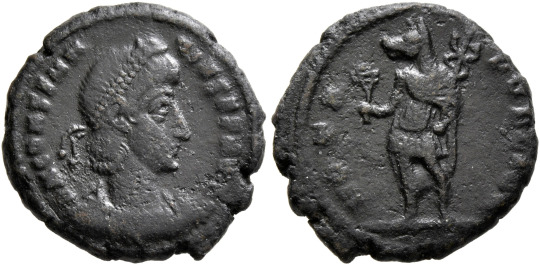
Constantius II, festival of Isis issue, struck 352-355 Obverse depicts diademed bust of Constantius facing right. Reverse depicts Anubis, standing left, holding caduceus and sistrum.
The festival of Isis coins are some of the most fascinating pieces struck by Rome in my opinion, especially when taking into consideration that these coins depicting Egyptian deities were still struck under notoriously Christian emperors.

Festival of Isis bronze, 4th century Obverse depicts bust of Isis facing right, wearing hem-hem crown. Reverse depicts Harpocrates standing left and holding a cornucopia
The festival itself was held to commemorate the arrival of the ship of Isis that departed from Alexandria and arrived in Rome on March 5th. The last known emperor depicted on a festival of Isis issue is Valentinian II, and the festival would stop being held in the city of Rome around 416.
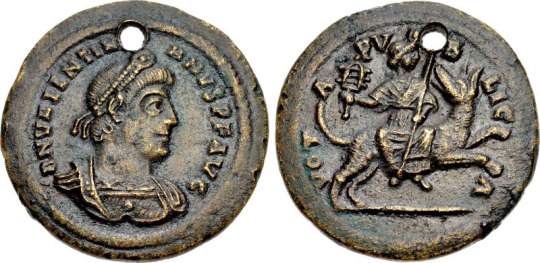
Festival of Isis medallion, Valentinian I, 364-375 Obverse depicts diademed bust of Valentinian I facing right. Reverse depicts Isis, holding sistrum and scepter, riding on Sothis.

Crispus, Festival of Isis issue, 316-326 Obverse depicts bust of Crispus facing right. Reverse depicts Isis Pharia on galley, standing to left, head facing right, holding sistrum.

Festival of Isis bronze, 4th century. Obverse depicts bust of Sol-Serapis facing right. Reverse depicts winged sphinx advancing right.
9 notes
·
View notes
Text
looking at the theodosian and valentinian dynasties gives me a headache. why is your family tree like this
#family tree singular because they intermarried and that feels absolutely incestuous in some kind of way#like why are you continuing the valentinian naming tradition on THAT side of the tree. get him AWAY from theodosius#(theodosius II enters the chat) no.....no it cant be..........they were co emperors. my god#(and ofc attila the hun is here)
1 note
·
View note